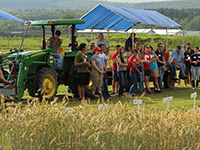Introduction | Participate | Understand | Monitor | Adapt | Mitigate | Activities | Case Studies | Links | Downloadable PDF
Simple garden-based activities like organic gardening, composting, and growing your own food can play a significant role in reducing greenhouse gas emissions and therefore assisting in the process of climate change mitigation. Find out more about the climate-related benefits of each garden-based activity below:
Organic Gardening:

Organic gardening is one of the best ways to reduce your carbon footprint! Rather than using petroleum-based synthetic fertilizers or pesticides, try using organic practices that focus on soil improvements and integrated pest management. When the amount of humus in the soil is increased, carbon emissions are kept out of the atmosphere. But soil can release carbon rather than capture it, if left exposed. Because carbon is concentrated in the top layer of soil, it is then vulnerable to oxidation, which increases emissions. It is therefore important to keep gardens covered with growing plants – perennial gardens are ideal! Mulching is another important practice in organic gardening. Organic gardening reduces the need to purchase petroleum-based products which increase fossil fuel emissions during their production and transport phases.
Composting:
- Did you know that the average family produces a ton of greenhouse gas emissions every year just from throwing out their food and garden waste?

Garbage in landfill sites release methane, a very active greenhouse gas that has worse potential to warm the planet than carbon. Composting those wastes, on the other hand, locks up carbon from the atmosphere for decades. Using homemade compost also eliminates those additional travel miles to the store for soil and fertilizers, products that have already been transported considerable distances.
Ecological Landscaping:
- Did you know that heating and cooling accounts for about 60% of a home’s energy consumption?
- Did you know that trees that are correctly positioned can save up to 25% of a home’s heating and cooling costs?
Through ecological landscaping, the right type of tree in the right position can reduce your heating and cooling costs substantially. It’s a good idea to plant leafy species on the south and west sides of buildings for summer shade and warm winter sunlight, while planting evergreens on the north side and shrubbery against the building foundation to protect it from winter winds. Blocking the wind can make a big difference to your heating costs. A well-placed windbreak of trees can reduce wind velocity by 85%. In addition, each shade tree absorbs about 50 pounds of carbon dioxide per year as it grows!
Growing Your Own Food:

- Did you know that the average food has traveled 2,000 miles before it ends up on your plate?
- Did you know that the average family creates more than 4 tons of greenhouse emissions just by the food miles from the food they buy at the grocery store?
Growing your own food in your garden helps to significantly reduce your carbon “foodprint”! Your food will be more fresh, nutritious and delicious too!
Related activities (pdfs):
Sustainable Gardening Practices









